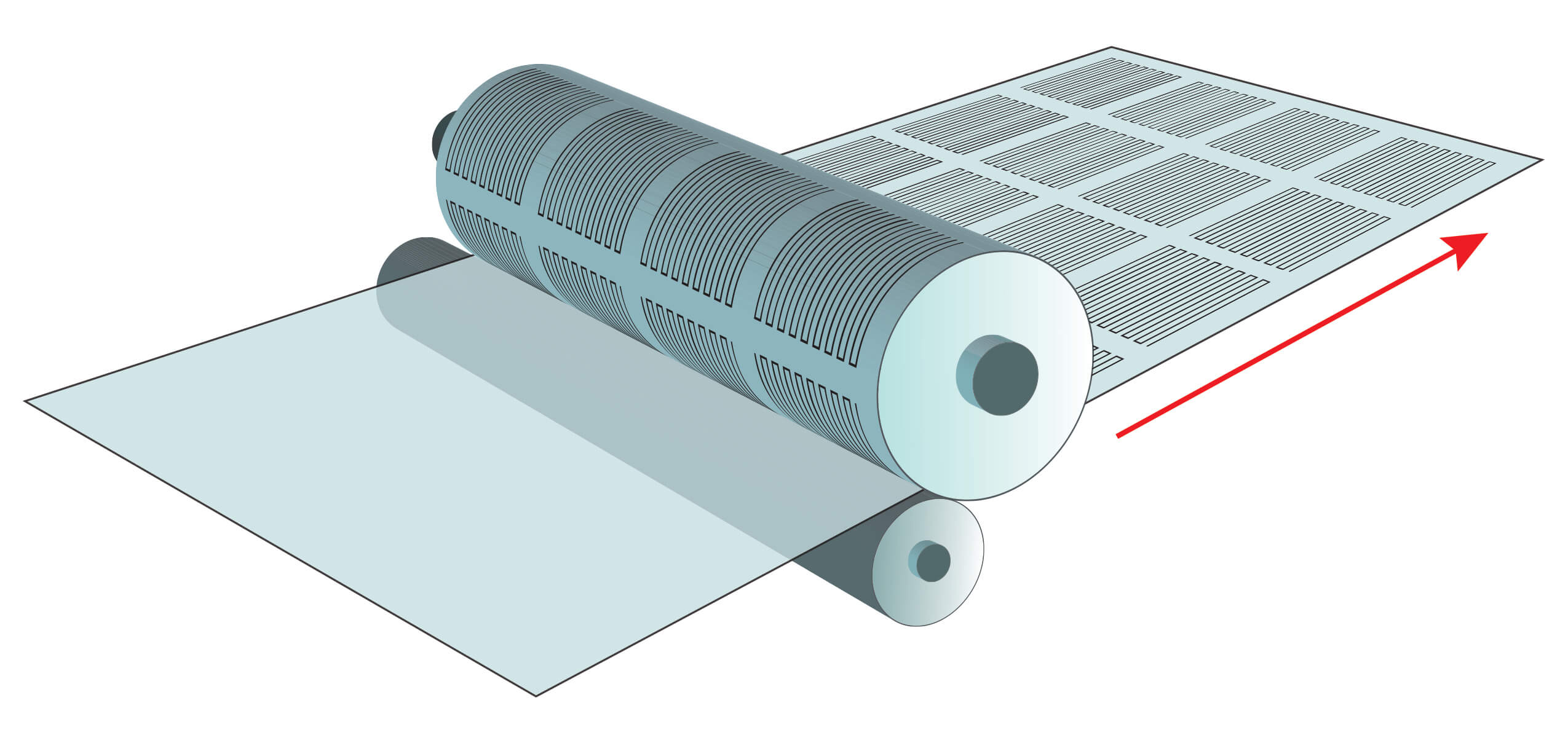Application Note, Custom Engineered Motion Systems, Integrated Automation Systems, Motion Control Platforms, Motors, Precision Manufacturing, Stages & Actuators
Application Note
Advanced Motion Control for Precision Drum Writing
Precision mechanical equipment, integrated advanced controls, laser control features and software come together to advance the state-of-the-art in drum writing.
High precision roll-to-roll manufactured drums are used to produce everyday items sold around the world. For example, these drums are used to manufacture credit card security holograms as well as special films to increase a screen’s brightness on cell phones and other LCDs. Increasingly sophisticated fraud protection techniques are leading to more advanced and complicated holograms, while electronics miniaturization has led to smaller embedded features on specialty films. Higher precision master drums are used to make these products. Precision motion control enables smaller and more accurate laser-written drum features by precisely moving the drum with respect to the focused laser beam and also by firing the laser at the appropriate times and locations.


So why is miniaturization so challenging for advanced motion control? The answer lies in the end product. To keep up with the technological advancements of complex patterns and reduced sizes of electronics, the individual imprinted/written features required are now sub-micron and in some cases must be accurately spaced to less than 100 nm from each other. Additionally, processing these drums can take weeks, which pushes manufacturers to produce higher speed systems. For example, a 300 mm diameter drum being processed at 50 rpm would require a laser pulse trigger every 0.0012 ms in order to create 1 µm laser-pulsed feature sizes on the outer circumference of the drum. This is equivalent to commanding the laser to fire every 1/5th the diameter of a human blood cell at a rate of 800,000 pulses per second and with point-to-point spacing of 1/1000th the width of a human hair. This is not a trivial undertaking.
Aerotech builds high-performance motion subsystems that solve the difficulties of feature miniaturization in roll-to-roll processes while holding the extremely tight accuracy tolerances required by the end product. The motion control technologies required to manufacture precision drums include high positioning resolution, high-accuracy mechanics, the ability to fire the laser based on the exact calibrated position of the drum and autofocus control features that allow the laser to operate at its optimal focal distance. Using this technology enables sub-micron feature sizes and <100 nm of individual feature-to-feature spacing.


Aerotech motion systems achieve sub-micron feature sizes by using high-resolution position feedback devices, precision air-bearing technology and advanced controls and drives. Typically, amplified sine feedback devices and a hardware multiplier board are used to achieve nanometer and sub- arc-second resolution. As an example, to electronically control the laser pulse spacing on a 300 mm diameter drum down to 1 µm, the rotary encoder attached to the axis rotating the drum needs to have a minimum of 0.00038 degrees of resolution and ideally an order of magnitude more than that to remove sampling errors. The bearing technology needs to allow for near frictionless movement of the axes in order to achieve sub-micron motions. This is enabled by air-bearings since there is no mechanical contact between the two bearing surfaces. Also, the mechanical equipment must be paired with high-performance drive electronics and software to control the motion down to nanometer resolutions. The control electronics need to have a high enough electrical resolution and low enough noise to command such incrementally small amounts of current to the motor on the positioning stage. Servomotor noise can be induced by electrically switching PWM amplifiers, so linear amplifiers should be used whenever possible. Aerotech builds systems using high-resolution encoders, air- bearing technology and linear amplifiers that result in a complete motion subsystem specifically designed and built to manufacture precision drum masters.
Now that the motion is possible, the process tool (laser) must be synchronized to the position of the drum or the features will be distorted or incorrectly located on the drum’s surface. Aerotech has developed the patented ability to fire a laser based on the calibrated position of the drum. This eliminates the concern of controller latency and motion profile shape, and directly uses the calibrated encoder feedback of the axes to command the laser when to fire. This feature is called Position Synchronized Output (PSO), and uses high-speed electronic hardware to communicate to the laser input channels. The positions of the axes are combined so that the laser firing is coordinated between the rotating drum and the linear motion of the laser. This feature can fire the laser at rates up to 12.5 MHz with latencies of only 160 nanoseconds.
Finally, autofocus routines built into the Aerotech controller allow for the laser focal length to be set at an optimal distance from the drum surface. This is important because the blank drums cannot be manufactured to hold the same concentricity tolerance over the entire length, resulting in various tapers. Autofocus routines mitigate the negative effects of these tapers. To utilize the autofocus routine, a positional displacement sensor is added to the system in the direction of the laser beam, and this measures the drum’s positional location with respect to the laser head or optic. Every laser will have an ideal focal distance where its spot size and intensity level is optimized, and this is where the autofocus routine will be set. The displacement sensor’s value can be input directly into the Aerotech control loop to command an axis of motion. This will maintain the ideal focal length for the laser beam and allow for consistent feature creation over the drum’s entire circumference and length.
As everyday roll-to-roll manufactured products become more technologically advanced, the methods by which the master drums are manufactured also need to improve. Miniaturization and the growing complexity of these products drives the need for motion subsystem advances in roll-to-roll manufacturing environments. Aerotech solves the problem with high-end mechanical equipment, integrated advanced control electronics and laser control features and software.
